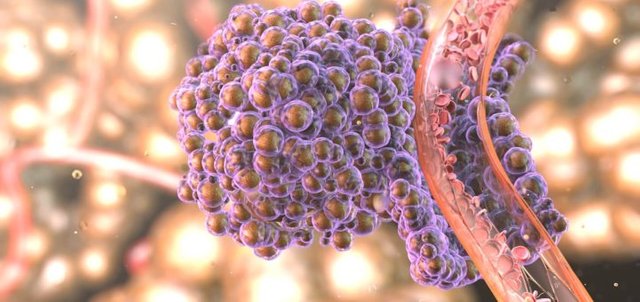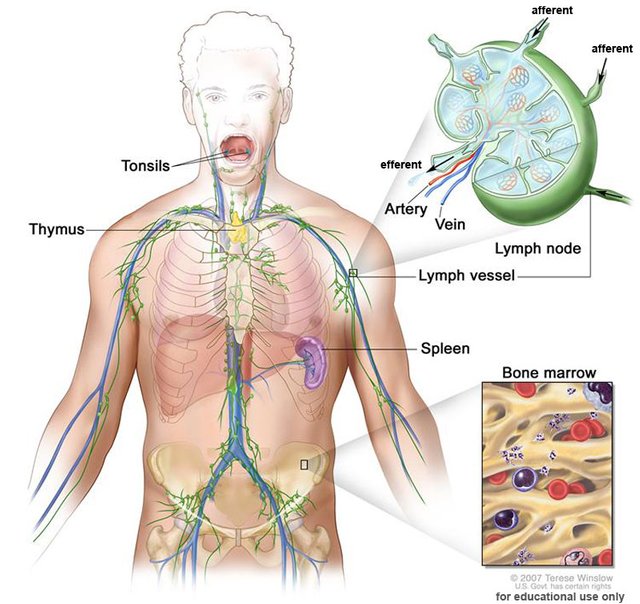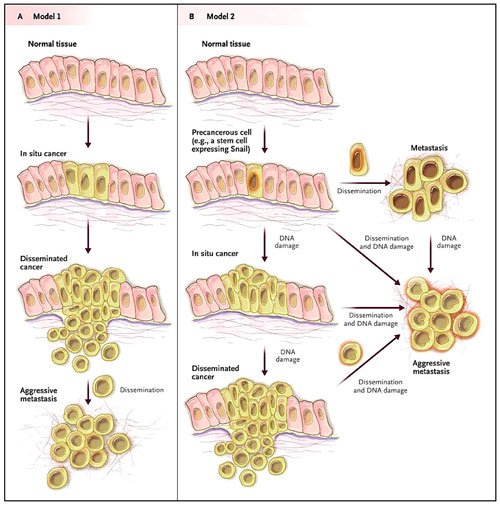Metastasis | As A Tumor Can Spread Throughout Our Body| Deep Look 👀
Hello friends of Stemit, a while ago that I do not publish, I was very busy with work, but today I bring you a topic that can be very interesting for many, I will talk about metastasis; It is a very complicated issue but it is necessary for everyone to have this information, giving a diagnosis of this type is difficult for both the doctor and the patient.
The metastasis always corresponds to a primary tumor, that is, a tumor that started with a cell or malignant cells in another part of the body.
Approximately 92% of deaths due to undetected cancers are due to the metastasization of these. Actually, although it is the best known, metastasis when the cancer develops is the same process of origin (cancer, infections) in the place where the cancer is produced. embolism
Let's start

What is metastasis about?
It is the process of propagating a cancerous focus to an organ other than the one in which it started. It usually occurs via the blood or lymph. (The lymphatic vessels look a lot like blood vessels, with the difference that they carry a clear fluid and cells of the immune system)
Cancers are able to spread through the body due to two mechanisms: invasion and metastasis. Invasion is the migration and direct penetration of cancer cells into neighboring tissues. Metastasis is the ability of cancer cells to penetrate the blood and lymph vessels, travel through the bloodstream, and then grow into a new focus (metastasis) in normal tissues elsewhere in the body.
Tumors are classified as benign or malignant, depending on whether they can invade locally or metastasize to distant organs. Benign tumors are those that can not be spread by invasion or metastasis; therefore they grow only locally. Malignant tumors are those able to spread by invasion and metastasis. By definition, the term "cancer" applies only to malignant tumors.
When cancer patients are diagnosed, it must be known if their disease is localized or has spread to other distant organs.
How can metastasis develop?
Metastasis occurs through a complex series of steps, the metastatic cascade, in which the cancer cells leave the original site of the tumor and migrate to other parts of the body through the blood or lymphatic circulation. The metastatic cascade begins with the rupture of the natural limits of the tissue, the basal lamina, in the case of the epitheliomas, through a process of invasion of the extracellular matrix. Invasion is followed by intravasation, a phenomenon in which the tumor cell enters blood or lymphatic vessel and proceeds to circulate through the body. The processes of inflammatory restriction and elasticity determine the arrest of the tumor cell in a capillary. After its arrest, the tumor cell proceeds to its extravasation to the perivascular connective matrix, to proliferate in its new settlement and form to metastasis. To invade the extracellular matrix, the malignant cells separate from the primary tumor and bind to the proteins of the surrounding extracellular matrix, which separates the tumor from the surrounding tissue. By degrading these proteins, the neoplastic cells can move through the extracellular matrix and escape their natural limits during embryonic development. When head and neck cancers metastasize, they commonly travel through the lymphatic system to the lymph nodes in the neck.
To have a clearer concept of the metastasis begins where the cancer originated is related to the place where it will spread. Most cancer cells that are detached from the original tumor are transported to the blood or lymphatic system until they are trapped in the next "downstream" organ or group of lymph nodes. Once the cells are there, they begin to grow and form new tumors. This explains why breast cancer often spreads to the lymph nodes in the armpits, but rarely to the lymph nodes in the groin. In addition, there are many cancers that commonly spread to the lungs. This is because of the blood pumps from the rest of the body through the blood vessels of the lungs before sending it to other places.
The investigation of the necessary conditions for cancer metastasis has discovered that one of the critical events required for the growth of tumors and the production of their metastases is the development of a new network of blood vessels. This process of forming new blood vessels is called angiogenesis.
Tumor angiogenesis is the proliferation of a network of blood vessels that enters the tumor, provides nutrients, oxygen and removes waste. Tumor angiogenesis may be favored by the cancer cells themselves, capable of producing molecules that send signals to the surrounding normal tissue. These signals activate certain genes in the host tissue that respond with the synthesis of proteins that stimulate the growth of new blood vessels.
Genetic Formation

The transformation of a tumor cell into a metastatic tumor cell involves transient or permanent genetic changes, which determine the expression of molecules with actions that favor or protect the mechanisms necessary for metastasis. Apparently, the doubt that had worried oncologists for centuries ("How does cancer produce all the complex processes necessary to develop a metastasis?") Has a very simple answer: it does not do anything by itself. Cancer is an altered tissue but it keeps all its own genes, normal or mutated, so it can be used to metastasize normal cellular mechanisms, which should have been inactivated after birth.
Recently, in 2004, researchers at the Massachusetts Institute of Technology (MIT) discovered that a gene located on chromosome 7 plays a central role in the production and spread of metastases to distant organs. The protein produced by this gene controls the reproduction of embryonic tissues, but normally it is completely deactivated once the fetus is already formed.
The responsible for this behavior is a gene that synthesizes a protein called "twist", whose normal function is to turn on and off other genes (or tell them when to activate and when not). Twist is very active in early embryonic development, when it directs the tissues in formation, helps to organize them and indicates where they need to migrate. Once its mission is accomplished, the twist protein "falls asleep" and remains inactive for the rest of the individual's life.
If the "gaudy" gene responsible for synthesizing twist in some metastatic cells is deactivated and then inoculated in experimental animals, they develop a tumor but no metastasis. If the tissue is injected without turning off the gene, the animal will develop the primitive tumor and one or more metastases-
Studies on the role of the Twist gene are still in their infancy. It has only been four years since its function has been understood and, even more so, only in one type of cancer (breast carcinoma) and only in two species (mice and us). Dr. Robert Weinberg, discoverer of the Gen Twist, says: "There are many other regulatory genes that have properties similar to Twist, they play, without doubt, similar roles and equally important in other types of metastatic cancers"
Where metastases develop

Metastasis to the bones, brain, liver, lymph nodes and lungs is common. Cancer cells can also metastasize to the pleural space (the lining around the lungs) or the abdominal cavity. This can cause an excess of fluid buildup in these areas (called malignant pleural effusions and malignant ascites). Multiple small metastases in the abdominal cavity are known as peritoneal carcinomatosis. Less often, cancer can also spread to the skin, muscles, or other organs of the body.
- Some cancers tend to spread to certain parts of the body. For example:
- Breast cancer tends to spread to the bones, the liver, the lungs, the chest wall and the brain.
- Lung cancer tends to spread to the brain, bones, liver and adrenal glands.
- Prostate cancer tends to spread to the bones.
- Cancers of the colon and rectum tend to spread to the liver and lungs.
Relevant information
The cancers that most metastasize are the most frequent cancers such as breast cancer, lung cancer, colorectal cancer.
When cancer has metastasized, it can be treated with chemotherapy, radiation therapy, biologic therapy, hormone therapy, surgery, or a combination of these. The choice of treatment generally depends on the type of primary cancer, the size, the location of the metastasis, the age, the general health of the patient and the types of treatments previously used. In patients diagnosed with metastases of unknown origin, it is still possible to treat the disease even when the primary tumor can not be located.
When a cancer presents metastasis it is in the most advanced stage or stage (stage IV). Some tumors such as testicular cancer and some lymphomas may be curable when you are in metastatic disease in most cases.
Although metastasis is widely accepted as the result of the migration of tumor cells, there is a hypothesis that some metastases are the result of inflammatory processes by abnormal immune cells. The existence of metastatic cancers in the absence of primary tumors also suggests that metastasis is not always caused by malignant cells that leave primary tumors.
Apalutamide Delays Metastasis by Over 2 Years in Prostate Cancer
As all my post I have brought an information, which is in development and may be of great importance to readers, In the end I will leave the link so you can continue with the news
Apalutamide (RNA-509) reduced the risk of metastasis or death by 72% in patients with nonmetastatic castration-resistant prostate cancer (CRPC), according to the phase III SPARTAN trial reported on a presscast ahead of the 2018 Genitourinary Cancers Symposium.
The median metastasis-free survival (MFS) was 40.5 months in the apalutamide arm versus 16.2 months in the placebo arm (HR, 0.28, 95% CI, 0.23-0.35, P <.0001). Based on these data, the FDA granted a priority review to apalutamide for use in this setting. The agency is scheduled to make its final decision by the end of April 2018.
"Overall, these data suggest that apalutamide should be considered as a new standard of care for men with high-risk non-metastatic castration-resistant prostate cancer," said lead author Eric J. Small, MD, professor of medicine at the University of California , San Francisco.
Conclusion
When you live with cancer for many months or years, doctors often treat it as a chronic (long-term) disease. As someone with another chronic disease, such as diabetes or heart failure, you need treatment. It is important to follow your treatment plan to make it work as well as possible. He also needs support for the physical, emotional and mental challenges of living with cancer.
It is important to ask your doctor about the goals of the treatment. These goals may change during your care, depending on whether the cancer responds to treatment. It is also important to know that pain, nausea and other side effects can be controlled with the help of your health care team. This is called palliative care and should be part of any treatment plan.
Ref Information
- National Cancer Institute: Metastatic Cancer: Questions and Answers
- Franci C, Zhou J, Jiang Z, Modrusan Z, Good Z, Jackson E, Kouros-Mehr H (2013). <>"Biomarkers of residual disease, disseminated tumor cells, and metastases in the MMTV-PyMT breast cancer mode
- "Metastatic Cancer: Questions and Answers". National Cancer Institute. Retrieved 2008-08-28.
- https://www.cancer.org/es/tratamiento/como-comprender-su-diagnostico/
- Chiang AC, Massagué J (December 2008). <>"Molecular basis of metastasis"
- Briasoulis E, Pavlidis N (1997). <>"Cancer of Unknown Primary Origin"
- https://www.cancer.gov/espanol/publicaciones/diccionario/def/metastasis
- https://es.wikipedia.org/wiki/Met%C3%A1stasis
- Shahriyari L (2016). <>"A new hypothesis: some metastases are the result of inflammatory processes by adapted cells, especially adapted immune cells at sites of inflammation
- https://www.cancer.net/navigating-cancer-care/cancer-basics/what-metastasis
- https://en.wikipedia.org/wiki/Metastasis
Thank you for taking the time to read this publication. I hope you have a happy day, see you in the next. Do not forget to leave a comment about what you thought, thank you very much.@juanjdiaz89







Very informative.actually these misdiagnosed and late diagnosed metastatic tumor are the leading cause of death worldwide.Hope it will end up one day!!
Great post, very informative. :)
Just another info, Epithelial tumors metastasize lymphogenic, and visceral through blood vessels.